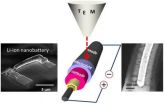(Press-News.org) Washington, D.C.—On March 17, the tiny MESSENGER spacecraft completed its primary mission to orbit and observe the planet Mercury for one Earth-year. The bounty of surprises from the mission has completely altered our understanding of the solar system's innermost planet. As reported in one of two papers published today on Science Express, scientists have found that Mercury's core, already suspected to occupy a greater fraction of the planet's interior than do the cores of Earth, Venus, or Mars, is even larger than anticipated. The companion paper shows that the elevation ranges on Mercury are much smaller than on Mars or the Moon and documents evidence that there have been large-scale changes to Mercury's topography since the earliest phases of the planet's geological history.
The mission's many successes have allowed it to be extended for another year. "The first year of MESSENGER orbital observations has yielded a wonderful harvest of results," says MESSENGER Principal Investigator Sean Solomon, of the Carnegie Institution and a coauthor of the two papers. "From Mercury's extraordinarily dynamic magnetosphere and exosphere to the unexpectedly volatile-rich composition of its surface and interior, our inner planetary neighbor is now seen to be very different from what we imagined just a few years ago. The number and diversity of new findings being presented this week to the scientific community in these papers and in presentations at this week's Lunar and Planetary Science Conference provide a striking measure of how much we have learned to date."
A Surprising Core
MESSENGER's radio tracking has allowed the scientific team to develop the first precise model of Mercury's gravity field which, when combined with topographic data and the planet's spin state, sheds light on the planet's internal structure, the thickness of its crust, the size and state of its core, and its tectonic and thermal history.
Mercury's core occupies a large fraction of the planet, about 85% of the planetary radius, even larger than previous estimates. Because of the planet's small size, at one time many scientists thought the interior should have cooled to the point that the core would be solid. However, subtle dynamical motions measured from Earth-based radar, combined with MESSENGER's newly measured parameters of the gravity field and the characteristics of Mercury's internal magnetic field that signify an active core dynamo, indicate that the planet's core is at least partially liquid.
Mercury's core is different from any other planetary core in the Solar System. Earth has a metallic, liquid outer core sitting above a solid inner core. Mercury appears to have a solid silicate crust and mantle overlying a solid, iron sulfide outer core layer, a deeper liquid core layer, and possibly a solid inner core. These results have implications for how Mercury's magnetic field is generated and for understanding how the planet evolved thermally.
Landscape Curiosities
A planet's topography can reveal fundamental information about its internal structure and its geological and thermal evolution. Ranging observations from MESSENGER's Mercury Laser Altimeter (MLA) have provided the first-ever precise topographic model of the planet's northern hemisphere and characterized slopes and surface roughness over a range of spatial scales. From MESSENGER's eccentric, near-polar orbit, the MLA illuminates surface areas as wide as 15 to 100 meters (50 -325 feet), spaced about 400 meters apart (1,300 feet).
The spread in elevations is considerably smaller than those of Mars or the Moon. The most prominent feature is an extensive area of lowlands at high northern latitudes that hosts the volcanic northern plains. Within this lowland region is a broad topographic rise that formed after the volcanic plains were emplaced.
At mid-latitudes, the interior plains of the Caloris impact basin — 1,550 kilometers (960 miles) in diameter — have been modified so that part of the basin floor now stands higher than the rim. The elevated portion appears to be part of a quasi-linear rise that extends for approximately half the planetary circumference at mid-latitudes. These features imply that large-scale changes to Mercury's topography occurred after the era of impact basin formation and large-scale emplacement of volcanic plains had ended.
These and other latest findings from MESSENGER will be featured in 57 papers presented this week at the 43rd Lunar and Planetary Science Conference in The Woodlands, Texas.
INFORMATION:
The Carnegie Institution for Science (carnegiescience.edu) is a private, nonprofit organization headquartered in Washington, D.C., with six research departments throughout the U.S. Since its founding in 1902, the Carnegie Institution has been a pioneering force in basic scientific research. Carnegie scientists are leaders in plant biology, developmental biology, astronomy, materials science, global ecology, and Earth and planetary science.
MESSENGER (MErcury Surface, Space ENvironment, GEochemistry, and Ranging) is a NASA-sponsored scientific investigation of the planet Mercury and the first space mission designed to orbit the planet closest to the Sun. The MESSENGER spacecraft launched on August 3, 2004, and entered orbit about Mercury on March 18, 2011 (UTC), to begin its primary mission – a yearlong study of its target planet. MESSENGER's extended mission began on March 18, 2012. Dr. Sean C. Solomon, of the Carnegie Institution of Washington, leads the mission as Principal Investigator. The Johns Hopkins University Applied Physics Laboratory built and operates the MESSENGER spacecraft and manages this Discovery-class mission for NASA.
END
Physicists who have studied the mixing between two incompatible fluids have found that it is possible to control the undercurrents of one circulating fluid to optimise its exposure to the other. This work, which is about to be published in EPJ E¹, was performed by Jorge Peixinho from CNRS at Le Havre University, France, and his colleagues from the Benjamin Levich Institute, City University of New York, USA.
The authors compared quantitative experimental observations of a viscous fluid, similar to honey, with numerical simulations. They focused on a fluid, which partially ...
URBANA – University of Illinois research reports that swine producers can feed distiller's dried grain with solubles (DDGS) to their pigs without concern for sulfur content.
"When you buy DDGS, you don't have to be concerned about the level of sulfur it contains because there doesn't appear to be any impact on pig performance," said U of I animal sciences professor Hans Stein.
According to the researcher, DDGS, a co-product of the ethanol industry, is used as a feed ingredient in diets fed to swine.
To maintain a stable pH in fermentation vats, ethanol producers ...
The Defense Department, faced with cuts of what Secretary Leon Panetta said could be $487 billion over the next ten years, can find tens of billions of dollars in cost reductions by better aligning the Pentagon supply chain rather than imposing precipitous reductions to the uniformed forces, according to a former Army colonel who is speaking at a conference hosted by the Institute for Operations Research and the Management Sciences (INFORMS®), the premier organization for advanced analytics professionals.
The INFORMS Military Applications Society Conference takes place ...
Amsterdam, NL, 21 March, 2012 – Fertility problems, recurrent miscarriages, and pregnancy complications can occur when maternal immunological tolerance of the fetus is impaired. Gérard Chaouat and colleagues from Inserm et Assistance Publique et Université Paris Sud Orsay, Hopital Antoine Bèclère, Clamart Cedex, France (now in Hopital Saint Louis, Paris), trace the evolution of the science of reproductive immunology to show how the current understanding of maternal-fetal tolerance/dialogue has developed, and its implications for the treatment of infertility disorders. ...
Remember Slinky®, the coiled metal spring that "walks" down stairs with just a push, momentum and gravity? Researchers at the National Institute of Standards and Technology (NIST) have developed their own version of this classic—albeit 10 million times smaller—as a novel technology for manipulating and measuring DNA molecules and other nanoscale (billionth of a meter) materials.
In the first of two recent papers,* Samuel Stavis, Elizabeth Strychalski and colleagues demonstrated that a nanoscale fluidic channel shaped like a staircase with many steps (developed previously ...
http://vinylletter.net specializes making custom vinyl lettering. With http://vinylletter.net what you see is what you get online editor, you can easily custom whole piece vinyl letter you want. We promise quality and fast delivery. http://vinylletter.net can let you specify letter spacing and line spacing for your vinyl lettering. ...
Could widespread conjugal visitation reduce sexual offending in prisons? It's a possibility, according to Stewart D'Alessio and his team from Florida International University in the US. Their work shows that in states where conjugal visits are permitted, there are significantly fewer instances of reported rape and other sexual offenses in their prisons. The study is published online in Springer's American Journal of Criminal Justice.
At present, there are two opposing theories of the causes of sexual violence. The feminist perspective asserts that sexual violence is motivated ...
CORAL GABLES, FL (March 21, 2012)—A team of researchers led by Michael H. Antoni, director of the Center for Psycho-Oncology Research at the University of Miami (UM) has shown that a stress management program tailored to women with breast cancer can alter tumor-promoting processes at the molecular level. The new study recently published in the journal Biological Psychiatry is one of the first to link psychological intervention with genetic expression in cancer patients.
According to the study, the group-based Cognitive-Behavioral Stress Management (CBSM) intervention ...
According to Cardinal Web Solutions, an Internet marketing firm in Atlanta, all business pages on Facebook will be converted to the Timeline format on March 30th 2012. While this may be the biggest change from a visual standpoint, the changes to features and the heretofore virtually unlimited versatility that has made Facebook an essential social media marketing tool will be a hard pill to swallow for many businesses.
Communications sent thru Facebook by businesses are being throttled to 16% per month of current Facebook fans that have "liked" your page. This ...
It turns out you can be too thin—especially if you're a nanoscale battery. Researchers from the National Institute of Standards and Technology (NIST), the University of Maryland, College Park, and Sandia National Laboratories built a series of nanowire batteries to demonstrate that the thickness of the electrolyte layer can dramatically affect the performance of the battery, effectively setting a lower limit to the size of the tiny power sources.* The results are important because battery size and performance are key to the development of autonomous MEMS—microelectromechanical ...



